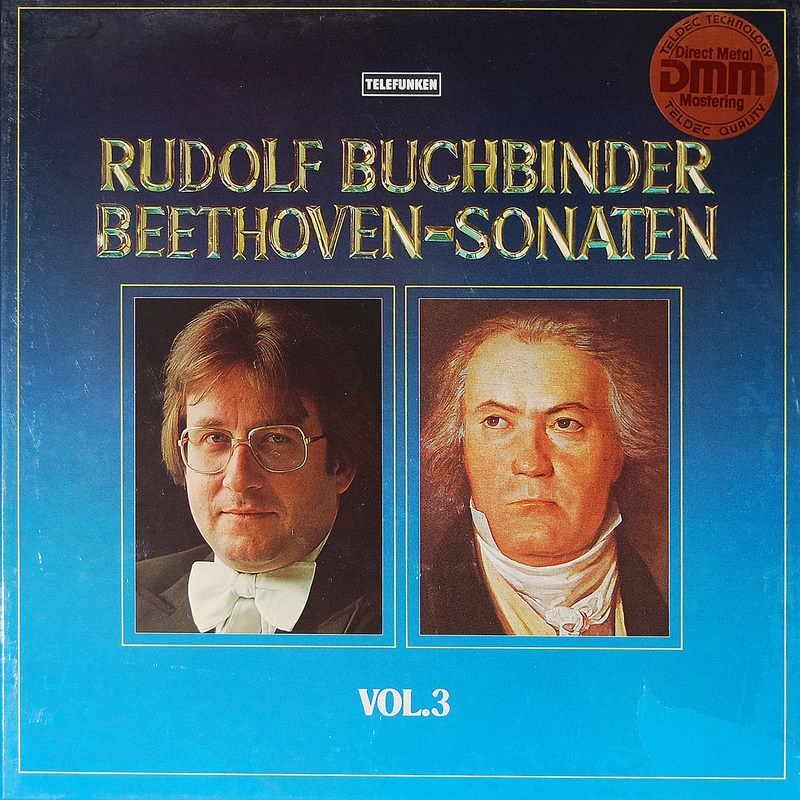 |
|
3 LPs
- 6.35581 FK - (p) 1982
|
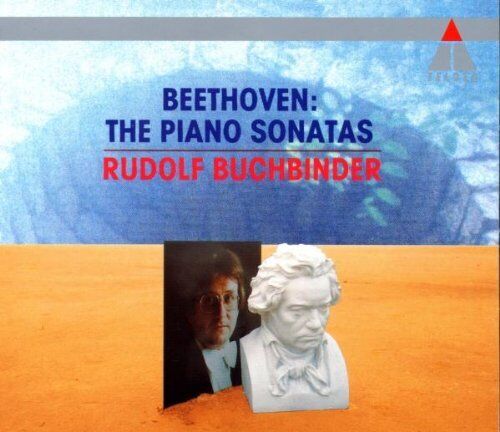 |
| 8 LCDs -
9031-71719-2 - (c) 1990 |
|
KLAVIERSONATEN
- Volume 3
|
|
|
|
|
|
|
|
| Ludwig van
BEETHOVEN (1750-1827) |
Klaviersonate
Nr. 4 Es-dur, Op. 7 - Der
Gräfin Babette von Keglevics
gewidmet (Komponiert um
1796/97)
|
|
27' 34" |
|
|
-
Allegro molto e con brio
|
7' 19" |
|
A1 |
|
-
Largo, con gran espressione
|
8' 38" |
|
A2 |
|
-
Allegro |
4' 57" |
|
A3 |
|
-
Rondo: Poco Allegretto e grazioso
|
6' 40" |
|
A4 |
|
Klaviersonate
Nr. 5 c-moll, Op. 10 Nr. 1 - Der
Gräfin Anna Margarete von Browne
gewidmet (Komponiert 1796/98)
|
|
17' 47" |
|
|
-
Allegro molto e con brio
|
6' 47" |
|
B1 |
|
-
Adagio molto
|
6' 50" |
|
B2 |
|
-
Finale: Prestissimo
|
4' 10" |
|
B3 |
|
Klaviersonate
Nr. 6 F-dur, Op. 10 Nr. 2 - Der
Gräfin Anna Margarete von Browne
gewidmet (Komponiert 1796/98) |
|
11' 10" |
|
|
-
Allegro
|
5' 15" |
|
B4 |
|
-
Allegretto |
3' 26" |
|
B5 |
|
-
Presto |
2' 29" |
|
B6 |
|
|
|
|
|
|
Klaviersonate
Nr. 11 b-dur,
Op. 22 - Dem
Grafen Johann von
Browne gewidmet (Komponiert
1799/1800)
|
|
24' 12" |
|
|
-
Allegro con brio
|
6' 58" |
|
C1 |
|
-
Adagio con molta espressione
|
8' 10" |
|
C2 |
|
-
Minuetto
|
3' 16" |
|
C3 |
|
-
Rondo: Allegretto
|
5' 48" |
|
C4 |
|
Klaviersonate
Nr. 16 G-dur,
Op. 31 Nr. 1
(Komponiert 1801/02)
|
|
23' 19" |
|
|
-
Allegro vivace
|
6' 13" |
|
D1 |
|
-
Adagio grazioso
|
8' 44" |
|
D2 |
|
-
Tondo: Allegretto
|
6' 24" |
|
D3 |
|
|
|
|
|
|
Klaviersonate
Nr. 26 Es-dur, Op. 81a "Les adieux" - Dem
Erzherzog
Rudolph von
Österreich
gewidmet
(Komponiert
1809/10)
|
|
16' 00" |
|
|
-
Das Lebewohl (Les adieux): Adagio ·
Allegro | Abwesenheit (L'Absence):
Andante espressivo
|
10' 48" |
|
E1 |
|
-
Das Wiedersehen (Le Retour):
Vivacissimamente
|
5' 12" |
|
E2 |
|
Klaviersonate
Nr. 27 e-moll, Op. 90 - Dem Grafen Moritz
von Lichnowsky
gewidmet
(Komponiert
1803/04)
|
|
11' 59" |
|
|
-
Mit Lebhafttigkeit und durchaus mit
Empfindung und Ausdruck |
4' 36" |
|
E3 |
|
-
Nicht zu geschwind und sehr singbar
vorgetragen
|
7' 23" |
|
E4 |
|
Klaviersonate
Nr. 31 As-dur, Op. 110
(Komponiert 1821)
|
|
20' 06" |
|
|
-
Moderato cantabile molto espressivo
|
6' 26" |
|
F1 |
|
-
Allegro molto
|
1' 59" |
|
F2 |
|
-
Adagio ma non troppo · Fuga: Allegro
ma non troppo |
11' 41" |
|
F3 |
|
|
|
|
Rudolf BUCHBINDER,
Klavier (Steinway-Flügel)
|
|
|
|
|
|
Luogo
e data di registrazione |
|
-
|
|
|
Original
Editions |
|
Telefunken
| 6.35581 FK | 3 LPs | LC 0366 |
durata: 53' 24" · 41' 14" · 49'
53" | (p) 1981 | ANA | stereo
|
|
|
Edizione CD
|
|
Teldec
| 9031-71719-2 | 8 CDs | LC
3706 | (c)
1990 | DDD/DMM | stereo |
Klaviersonaten Nr. 1-32
Teldec | 8.43206 ZK | 1 CD | LC
3706 | (c)
1985 | DDD/DMM | stereo |
Klaviersonaten Nr. 4, 26
Teldec
| 8.43476 ZK | 1 CD | LC 3706 |
(c)
1987 | DDD/DMM | stereo |
Klaviersonate Nr. 5, 6
Teldec |
8.43111 ZK | 1 CD | LC 3706
| (c)
1985 | DDD/DMM | stereo |
Klaviersonate Nr. 11, 27
Teldec
| 8.43334 ZK | 1 CD
| LC 3706 | (c)
1986 | DDD/DMM |
stereo |
Klaviersonate Nr. 16
Teldec
| 8.43027 ZK |
1 CD | LC 3706
| (c)
1984 | DDD/DMM
| stereo |
Klaviersonate
Nr. 31
|
|
|
Executive
Producer |
|
-
|
|
|
Recording
Engineer |
|
-
|
|
|
Cover |
|
Ludwig
van Beethoven, Gemälde von J. W.
Mähler, 1815
|
|
|
Note |
|
- |
|
|
|
|
|
BUCHBINDER
BEETHOVEN
32 KLAVIERSONATEN
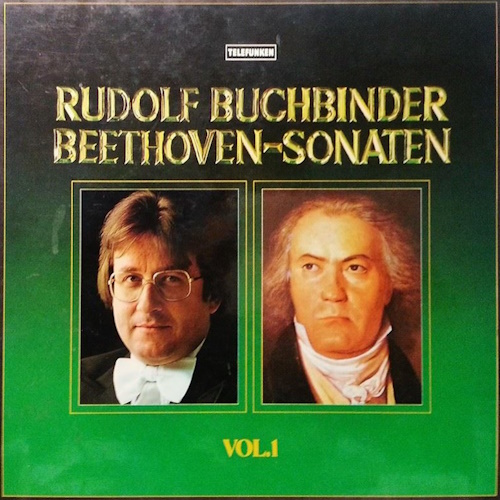
3 LPs - 6.35472 FK - (p) 1980
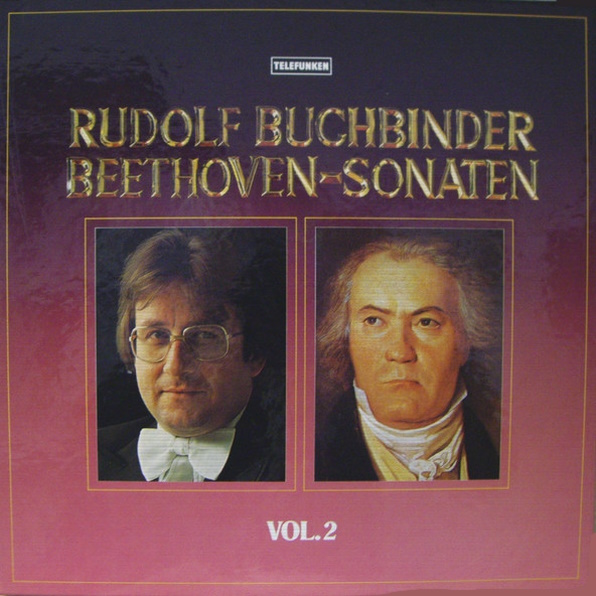
2
LPs - 6.35490 FK - (p) 1981

3 LPs -
6,35581 FK - (p) 1982
3 LPs -
6.35596 FK - (p) 1982 |
RE-RELEASE
ON
COMPACT DISC (DMM)

1 CD - 8.43206 ZK - (c) 1985
(Nr.4,26)
 1 CD - 8.43476 ZK
- (c) 1987 (Nr.5,6)
1 CD - 8.43476 ZK
- (c) 1987 (Nr.5,6)
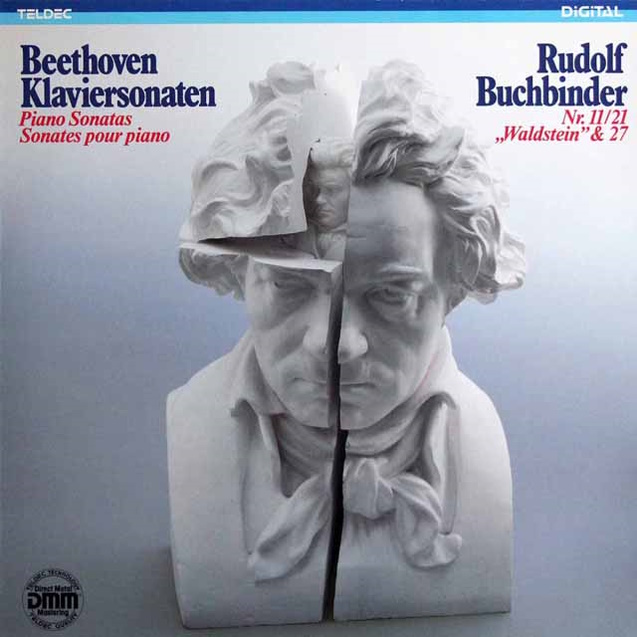
1 CD -
8.43111 ZK - (c) 1985
(Nr.11,27)
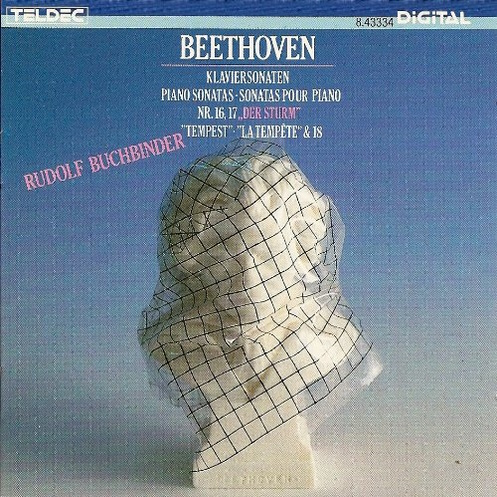
1 CD -
8.43334 ZK - (c) 1986
(Nr.16)
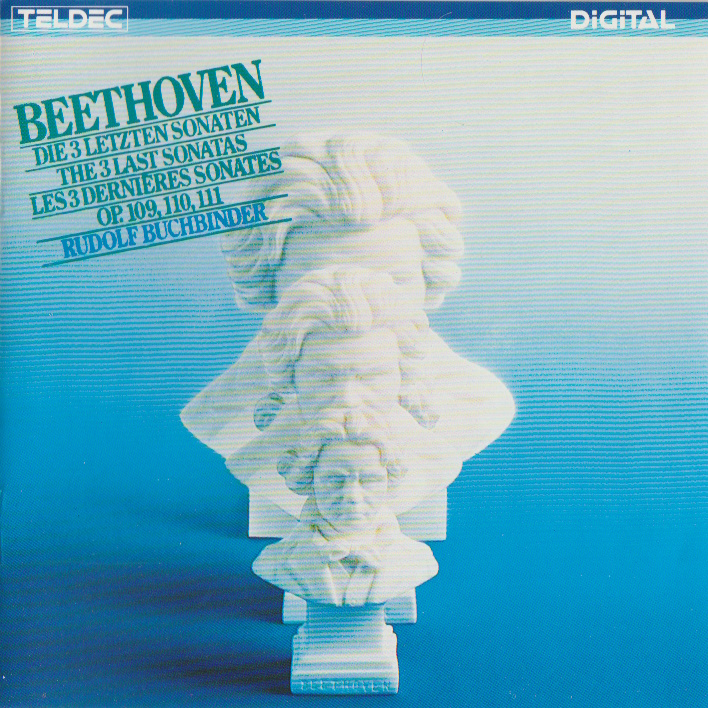
1 CD -
8.43027 ZK - (c) 1984
(Nr.31)
|
Piano
Sonatas Nr. 4 Es-dur, Op. 7
The E-flat major sonata was
composed in 1796/97, shortly
after Beethoven’s first three
“essays” in the medium, op. 1,
and is among the least often
played sonatas, although it is,
after the Hammerklavier sonata,
the longest. Op. 7 was given the
nickname - subsequently
forgotten - “Die Verliebte” (In
Love), perhaps because of
Beethoven’s supposed reverence
for the dedicatee, Countess
Keglevics (one of his noble
pupils), or perhaps on account
of the “gran espressivo” of the
slow movement. In any case, this
largo, which opens with such
simple “question-and-answer”
phrasing, has such a wide scale
of expression, that it quite
surpasses the largo appassionato
of op. 1/2, though the latter is
quite comparable in terms of the
type of movement. The dynamic
contrasts are blunt yet refined,
the rhythmic and articulatory
differcntiations are subtly
calculated against considerable
harmonic breadth. (However, the
extravagances of key in the
largo produce a link with the
first movement - a connection
between two sonata movements, in
other words, which has nothing
to do with thematic
relationships.)
The first subject of the first
movement is one of those
Beethovenian themes which play
on the listener’s uncertainty as
to where “the subject” actually
begins - with the four-bar block
of the E-flat minor chord, or
with the figuration that follows?
(A similar dilemma occurs in the
Eroica and the sonata op. 22.)
Right up to the end of this
lively, virtuoso movement, which
reintroduces the opening bars,
this time piled up on one
another in inverse order, these
contrasting elements (which also
appear in new combinations) and
the simultaneous close linking
of the different subjects result
in a dialectic interplay loaded
with tension.
The third movement is, formally
speaking, a schcrzo, but does
not appear to be one - nor is it
described thus. With the melody
hidden in its stormy middle
section, the movement recalls
Schubertian characteristics from
a distance.
Piano
Sonata Nr. 5 c-moll, Op. 10
Nr. 1
Almost exactly contemporary
with the op. 7 sonata and the
three string trios op. 9, the
three sonatas of op. 10
appeared in 1798. They are
dedicated to the wife of Count
Browne, whom Beethoven lauds
in the grandiloquent
dedication of his op. 9 as ”a
gentleman of fine feelings and
boundless generosity”, as ”the
first Maecenas of my music”.
(The Count had, among other
presents, given Beethoven a
horse, Beethoven - the
anecdote was passed on by his
pupil Ferdinand Ries - ”rode
the animal a few times, but
soon forgot about it”.) The
order of the three sonatas
distinctly recalls the op. 2
trios: in op. 10, too, the
first work is an energetic,
intense piece in the minor,
the second a cheerful,
decorative work in the major,
here, too, the first two
sonatas are fairly
light-weight, as if preludes
to the last and most important
sonata. Indeed, the parallels
can be taken further: while
op. 2/1 opens with an
universal motif (the so-called
”Mannheim rocket”), the first
movement of op. 10/1 recalls
an earlier composition,
Mozart’s sonata KV 457, which
is also in C-minor. The
similarity is so striking that
it can hardly be coincidence,
and even holds for details
like the suprise effect of the
use of the major variant of
the main subject for the
exposition. Yet Beethoven’s
sonata movement possesses a
previously unheard bizarre
furore, an outbreak shaken by
rash impulses which makes
contemporary critics’
ill-concealed resentment of
such ”wild thoughts” quite
understandable, if one takes
the tempo indication allegro
con brio at face value. It is
hard to imagine that this
sonata could be so degraded
and disembowelled that near
beginners are expected to
stumble through it!
After the calm cantabile of
the A-flat major middle
movement - into which only an
occasional reminiscence of the
first movement seems to
infiltrate (in the unexpected
forte cascades) - the finale
resumes the furious character
of the opening movement. Here
once again is an extreme
tempo, and abrupt dynamic and
thematic contrast,- all the
richness of a sonata movement
is compressed into the most
meagre dimensions - the
development, closing with a
hammering 4/8 motif that
anticipates the Fifth Symphony
and the Appassionata, numbers
only eleven bars. The sonata
finally expires in an unreal
major passage, piano on the
lowest bass notes.
Piano Sonata Nr. 6 F-dur,
Op. 10 Nr. 2
Something of the ”fantastic
humour” that Carl Czerny (in
his notes to the Beethoven
sonatas) found in Beethoven's
work appears in the finale of
op. 10/2: It is a movement
which begins like a three-part
fugue, then switches
immediately to the character
of a scherzo in even time;
nevertheless, a second subject
is introduced, in the manner
of a sonata movement, which in
fact only comprises a variant
of the fugal subject - a
wanton, genial game of
perpetuum mobile with various
musical characteristics. If
the scherzo model is, as it
were, incorporated into the
finale, then the allegretto of
the middle movement, albeit
written in the 3/4 time of a
scherzo, really represents the
missing slow movement in its
contemplative D-flat major
central section: the harmonies
are already quite Schubertian.
(Op. 10 nos. 1 & 2 are
both three-movement works: the
slow movement is ”missing”
from the first sonata, while
the second sonata lacks the
scherzo. These are but two
instances of Beethoven's
individual reorganization of
the conventions of external
form; in his piano sonatas
there is no “normal” order of
movements, in contrast to
those of Mozart with their
regular three-movement plan.)
Elements of mischievous good
humour are also to be found in
the first movement of op. 10/2:
almost the entire development
is based on the simplest
possible motif from the three
notes of the last bar of the
exposition, which span an
octave. If, however, one
starts to analyse, it turns
out that the same three notes
also correspond to the
beginning of the second
subject, which is, in turn,
clearly derived from a phrase
in the first subject. Again,
in the "false reprise”
(D-major instead of F-major),
the characteristic second
triplet phrase is also
"falsely" written - one note
too high - and the “wrong” key
is framed by too many - and
thus metrically “wrong” -
pauses that the listener
cannot help but notice. Great
artistry appears herr - in
contrast to the fury of op.
10/1 - with smiling
nimbleness.
Piano
Sonatas Nr. 11 B-dur, Op. 22
With the sonata op. 22,
composed 1799/1800, and with
the First Symphony, which
appeared in 1802 and was
dedicated to Count Browne,
Beethoven returned to the
great four-movement cycle, the
“normal” form, which had in
the meantime established
itself for the symphony and
the string quartet, but which
Beethoven only used now and
again for his piano sonatas.
“This sonata is a real
humdingerl”, he wrote to his
Leipzig publisher Hoffmeister,
and by this he meant the
virtuoso demands of the first
and last movements. The
character of the first
movement is determined by
triumphant élan, unbroken
kinetic joy which lets the
different subjects proceed
almost on their own in ever
new variants og the initial
triadic arpeggio. Some of the
figures, taken on their own,
could very well have been
borrowed from an organ work by
Bach, with their marked
characterization and their
tendency to polyphonic
constructions. The menuetto is
also market by a middly
anachronistic intrusion, with
an almost archaic sound which
only in the minor central
section turns without warning
into a scherzo. The expansive
adagio, on the other hand, is,
in the strongest possible
contrast to the dazzling
virtuosity of the first
movement, one of those slow
movements of Beethoven's that
convey a whole world of
musical sensations in an
overflowing wealth of timbres,
of harmonic nuances,
variations and decorations -
one seems to hear a "piano
orchestra",
Piano
Sonatas Nr. 16 G-dur,
Op. 31 Nr. 1
The
G-major sonata op. 31/1 -
probably the second sonata
composed by Beethoven - is
remarkable in its first
movement above all for the
rhythmic trick of
“anticipation”, whereby the
right hand literally comes in
a semiquaver earlier than the
left, thus artificially
producing an upward beat. This
device is expounded so
protractedly in the opening
bars that the “normal” chords
in bars 10/11, played
simultaneously by both hands,
somehow seem wrong! Beethoven
plays nothing short of
excessively with this rhythmic
idea in the development and in
the expansive coda. (Sketches
show that this device was
obviously the central idea for
the movement, which Czerny
accurately described as
”energetic, humorous and
wittily lively”.) The finale
also has a similarly long
coda, with witty distortions
of the subject and sharply
contrasting adagio insertions.
(Czerny: “very humorous,
somewhat Baroque in
character”.) In the first
movement, the first subject
contrasts with the second
rhythmically as well as
harmonically: rhythmically, in
that it proceeds as smoothly
as possible, with steady
quaver basses, almost in the
manner of a simple contredanse
melody, harmonically, one is
surprised by a third-related
B-major, which returns in the
epilogue in an utterly
Schuhertian interplay with
B-minor. While the first
movement consists to a large
extent of ”exploitation” of a
rhythmic device, the second,
with the unusual tempo marking
adagio grazioso, gives the
impression of being a
variation on types of attack
and phrasing (legato, non
legato, portamento and above
all staccato), which affects
all the main parts of the
movement, and, together with
the trills and nimble
figurations, lends it rather
the character of a gracefully
performed serenade. The last
bars of the movement, however,
deviate unexpectedly from the
serenade mood, with their
intimate sound.
Piano
Sonatas Nr. 26 Es-dur,
Op. 81a "Les adieux"
The
sonata was composed in
1809/10, directly after the
sonatas op. 78 and 79, and at
the same time as the string
quartet op. 74, the Piano
Concerto no. 5 and the Egmont
music. It is Beethoven’s only
sonata which - in contrast to
the many sonatas to which a
particular content or context
is attributed, or which have
been given titles felt to be
appropriate, like the
Moonlight or the Appassionata
- has a “real” programme. And
it is this very sonata which
we fail to call by its correct
name! The publisher Breitkopf
brought out two different
editions of the sonata - one
with the original German
title, and another on his own
initiative with the title in
internationally fashionable
French. The latter came in for
harsh criticism from
Beethoven: “Why on earth
change the title? ”Lebewohl”
(farewell) is nothing like
”Les Adieux” - the former is
an intimate goodbye between
two friends, while the latter
would be used with a group of
people.” The correct title is
”Lebewohl, Abwesenheit und
Wiedersehn. (Farewell, Absence
and Reunion.) Sonata for
Pianoforte dedicated to his
Imperial Highness Rudolph of
Austria.”
Archduke Rudolph, the son of
Emperor Leopold II, later
Archbishop of Olmütz
(Beethoven belatedly composed
the Missa Solemnis for his
enthronement as Archbishop)
had been Beethoven’s pupil,
patron and friend since 1804,
and the composer dedicated a
number of his most important
works to him in gratitude. In
May 1809 the Imperial family,
including the Archduke, fled
from Vienna before the
approaching Napoleonic troops,
and did not return until
January 1810. This, then, was
the inspiration for the sonata
op. 81a, as is stated quite
unambiguously in the
manuscript: “The
Farewell/Vienna, 4th May 1809/
at the departure of His
Honourable and Imperial
Highness the Archduke
Rudolph.” The adagio
introduction to the first
movement (the Farewell) begins
with a descending three-note
motif, beneath which the
composer inscribed “Le-be
wohl” in the manuscript. This
motif also dominates the
extended coda, similar to a
long drawn-out farewell, and
is the springingpoint for the
descending scales from which
all the subjects of the
allegro section are formed.
The second movement (Absence),
which takes up where the
adagio introduction of the
first movement left off, is a
musical image of a long,
painful parting, while the
third movement (Reunion)
conjures up touching happiness.
Piano
Sonatas Nr. 27 e-moll, Op.
90
The op. 90 sonata
of 1814, the next one to be
written after op. 81a, belongs
to these years of violent
political turmoil in which -
and this surely had something
to do whith the disturbances -
Beethoven’s creative powers
deteriorated somewhat. In any
case, the composer had hardly
written any large-scale works
since 1810, apart from the
Seventh and Eighth Symphonies
and the final version of
Fidelio (1814), though not a
few occasional pieces of a
patriotic nature had appeared.
"All lovers and connoisseurs
of music", the Wiener Zeitung
reported with relief in 1815
"will more than welcome the
appearance of this sonata,
since nothing for pianoforte
has flowed from Mr.
Beethoven's pen for several
years." Count Moritz
Lichnowsky, to whom Beethoven
dedicated the sonata in
gratitude for his mediation in
a matter of fees, was on a
friendly footing with
Beethoven; likewise his
brother Carl (died 1814), who
was one of Beethoven's most
important patrons.
In both movements of this
short sonata it is striking
that an as yet unknown
importance is given to the
cantabile: quite simply, it is
the basic posture of both
movements, rather than being
confined to particular thematic
areas as it used to be. (Only
in the development of the first
movement does a more energetic
manner come through.) The
second movement in particular,
a rondo with echoes of sonata
form, is eminently "singable"
(as Beethoven specified in his
performing directions,
written, unusually, in German)
- the music flows softly and
uniformly in Schubertian
fashion. Czerny commented
specifically on this novel “bel
cantabile”, which also plays a
most central rôle in the
following sonatas, op. 101,109
and 110.
Piano
Sonatas Nr. 31 As-dur, Op. 110
The three sonatas op. 109, 110
and 111, written down "at a
stroke" as Beethoven said, were
the only large works that the
composer had the strenght for
alongside his lenghtly struggle
with the Missa Solemnis
(1819-23). (Beethoven described
the sonatas as "bread-and-butter
work" which he need for his
"subsistence".) In op. 110,
composed 1821/22, the first
movement falls in with the free
fantasy-like form of the first
movement of op. 109 in that it
resembles a free variation on a
single theme rather than the
classical sonata model. (The
second sonata theme is there,
formally speaking, but it
remains an episode of just a few
bars; the first two bars of the
main theme undergo varying
harmonic illumination in the
scanty development section; in
the reprise, which follows
without a break, characteristic
rhythmic accompaniment figures
are variously interchanged vis à
vis the exposition.) The
character of the movement is
determined here, as in op. 90,
by the prevailing cantabile -
"con amabilità" (tenderly),
Beethoven elucidates at the
beginning of the movement.
The final movement - which is
preceded by a scherzo middle
movement in even tempo - carries
great weight in this sonata.
Like the third movement of the
string quartet op. 132, which is
similarly constructed, the finale
of op. 110 follows a
quasi-psychological course:
introduction with a highly
expressive recitative ("arioso
dolente - plaintive song"); the
first part of a fugue, breaking
off at an arpeggio; variation of
the arioso ("weary, plaintive"),
a half-tone lower than before,
ending in a faltering of the
music; "gradually coming back to
life", the second part of the
fugue, beginning with the
inversion of the theme, then
combining this inversion with
the form of a conclusion in ever
greater movement until the end
of the sonata.
One cannot rule out a connection
between this music and the
composer’s serious illness of
1821. In Novembre of that year
he wrote to a friend: "I feel
somewhat better now, thank God -
at last, good health seems to be
flowing back into me, to be
reviving me so that I can
dedicate myself to my art as has
not been the case for two years.
This because of ill health and
so many other human
afflictions...".
Jean
Meuchtelbach
(Translation: Clive R.
Williams)
|
|